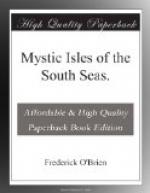They put down boats and tried to tow off their ships, but the tide set them in more and more toward the rocks. For many hours they despaired of saving the vessels, though they used “warping-machines,” anchors, and kedges. From my cook-house I saw where they had struggled for their lives with breaker, current, and chartless bottom. A light breeze off the land saved them, and in another day they returned to “obtain cocoanuts, plantains, bananas, apples, yams and other roots, which were exchanged for nails and beads.” From the very pool into which I dived Cook’s hearties filled their casks with fresh water, after shooting “two muskets and a great gun along the shore to intimidate the Indians who were obstinate.”
Cook, on his third voyage to Tahiti, found here a large wooden cross on which was inscribed in Latin:
Christ
conquered
Charles
the Third Emperor
1774
It was plain that Spaniards had erected the cross, for Charles III was King of Spain. These English tars hated the dons, with whom they had but recently been embattled. When they were convinced that a Spanish ship had been at Tautira twice since they had departed, and that the builders of the cross had earned the respect and affection of the natives, the Britons, in their old way of fair and assertive dealing, left the cross standing after carving on the reverse in good Latin as a claim of prediscovery:
George
III King
1767,
1769, 1773, 1774, 1777.
Two Spanish priests, they learned, had lived in the village between the arrival and return of the Spanish ships from Peru. They left no imprint of their Catholic religion except the cross and a memory of kindness; and why they resigned their mission to Tahiti is not known. The British missionaries did not come until 1797, on the Duff. They planted gardens and worked diligently and prayed. They had vast patience, and confidence in their all-powerful and avenging God, and a rapt devotion to his son, who forgave the sins of those who adopted His faith. Their ideals were as fixed as the stars, and their courage superior to the daily discouragements of their lives and continuous hardships of separation from home. But they could not break the strength of the superstitions of the pagans. A dozen years these English ecclesiastics delved in their gardens, built their houses, and begged Jehovah and Jesus to give them victory. Five years they mourned without message or aid from England. Their clothes were in tatters, and as covering their whole bodies with European garments from feet to scalp, except face and hands, was a rigid prescription of their own morals’ and an example to the almost nude Tahitians, they suffered keenly from shame. When, after half a decade, a brig arrived, its supplies were found ruined by salt water and mold. The poor clerics, in an earthly paradise, but hostile atmosphere, with little




